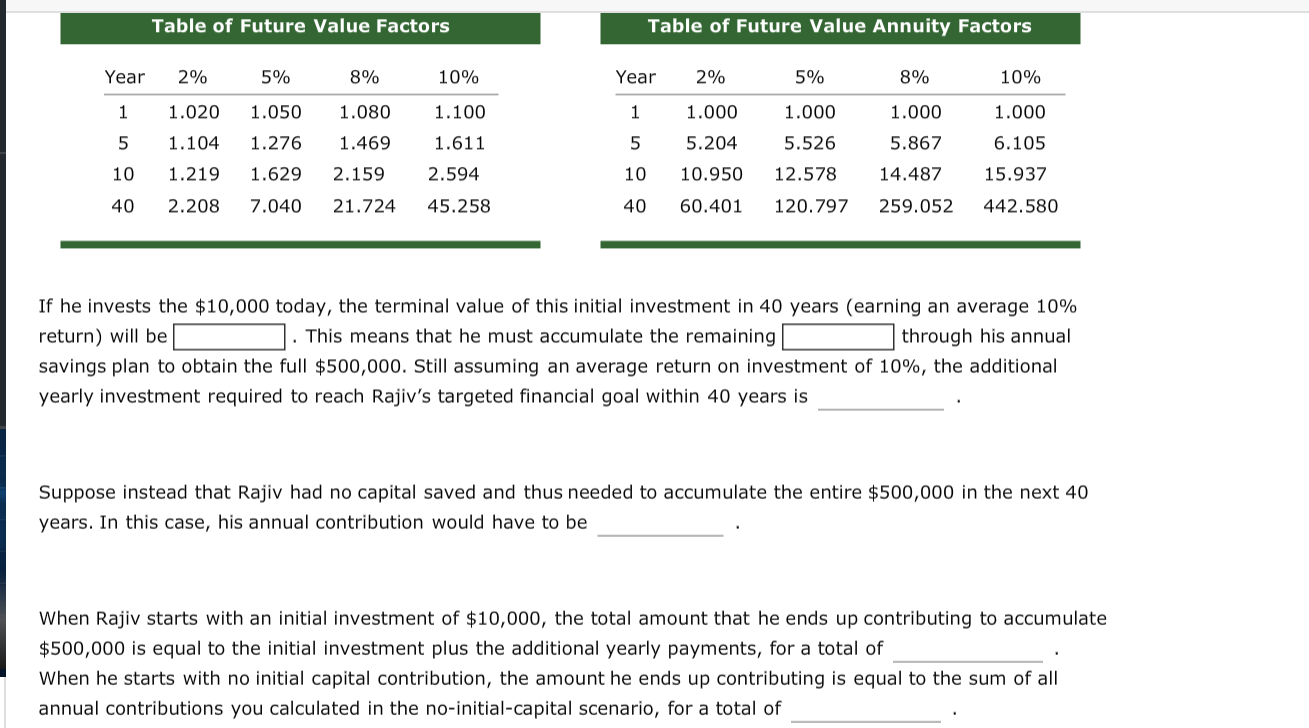
Table of Future Value Factors Table of Future Value Annuity Factors 5% 8% 10% Year 1 5 10 40 2% 1.020 1.104 1.219 2.208 5% 1.050 1.276 1.629 7.040 8% 1.080 1.469 2.159 21.724 10% 1.100 1.611 2.594 45.258 Year 1 5 10 40 2% 1.000 5.204 10.950 60.401 1.000 5.526 12.578 120.797 1.000 1.000 5.867 6.105 14.487 15.937 259.052 442.580 If he invests the $10,000 today, the terminal value of this initial investment in 40 years (earning an average 10% return) will be . This means that he must accumulate the remaining through his annual savings plan to obtain the full $500,000. Still assuming an average return on investment of 10%, the additional yearly investment required to reach Rajiv's targeted financial goal within 40 years is Suppose instead that Rajiv had no capital saved and thus needed to accumulate the entire $500,000 in the next 40 years. In this case, his annual contribution would have to be When Rajiv starts with an initial investment of $10,000, the total amount that he ends up contributing to accumulate $500,000 is equal to the initial investment plus the additional yearly payments, for a total of When he starts with no initial capital contribution, the amount he ends up contributing is equal to the sum of all annual contributions you calculated in the no-initial-capital scenario, for a total of Table of Future Value Factors Table of Future Value Annuity Factors 5% 8% 10% Year 1 5 10 40 2% 1.020 1.104 1.219 2.208 5% 1.050 1.276 1.629 7.040 8% 1.080 1.469 2.159 21.724 10% 1.100 1.611 2.594 45.258 Year 1 5 10 40 2% 1.000 5.204 10.950 60.401 1.000 5.526 12.578 120.797 1.000 1.000 5.867 6.105 14.487 15.937 259.052 442.580 If he invests the $10,000 today, the terminal value of this initial investment in 40 years (earning an average 10% return) will be . This means that he must accumulate the remaining through his annual savings plan to obtain the full $500,000. Still assuming an average return on investment of 10%, the additional yearly investment required to reach Rajiv's targeted financial goal within 40 years is Suppose instead that Rajiv had no capital saved and thus needed to accumulate the entire $500,000 in the next 40 years. In this case, his annual contribution would have to be When Rajiv starts with an initial investment of $10,000, the total amount that he ends up contributing to accumulate $500,000 is equal to the initial investment plus the additional yearly payments, for a total of When he starts with no initial capital contribution, the amount he ends up contributing is equal to the sum of all annual contributions you calculated in the no-initial-capital scenario, for a total of







